Getting to Know Your Roots
Our second Healthy Eating Lesson of the year focused on foods we eat that are roots. Read on to learn how we are helping students make connections about the food they eat and how it grows.
In our Healthy Eating Lessons this year we are focusing on the parts of the plant. We have discussed seeds and are now talking about roots. The root of the plant absorbs nutrients and water, two essential things needed for the plant to grow! As plants get bigger above ground and require more nourishment, their root systems often grow deeper as well in search of more sustenance underground.
At the beginning of a recent lesson at an afterschool program, one of our educators asked the students to name all of the foods we eat that are roots. The group started off strong naming potatoes, carrots, and onions. One student raised her hand and started describing something, “those crunchy red things in a salad…?” Her friends started trying to name what she was thinking of until one student exclaimed, “A radish!” They all nodded in agreement. Another student knew that beets were the root of the plant!
In the mix of all of these root vegetables were some other answers: lettuce, corn, tomatoes. At first, our leader thought maybe the group misheard her and explained, “All of those foods have roots, yes! But which are the foods that we eat the root of?” More answers were mixed into the jumble: beans? squash? apples? It seemed that the students did not have a true understanding of what different parts of the plant we eat and where their food comes from. This is something we find often when educating children from urban areas as well as from rural areas like Hunterdon County.
After experiencing this disconnect people have between the food they eat and where it comes from, our team made a realization that seems funny at first but in reality is quite startling. People tend to think of farmers like they do astronauts. An astronaut gets in a spaceship, presses some buttons, and magically ends up on the moon! Similarly, a farmer gets on his tractor and presses some buttons, and food magically ends up on your table (and for many it is often processed and far from its natural form). However, there is no magic in either case – it’s science! This moment with the children proved yet again how essential our work is, and because we recognize the problem – a huge disconnect in knowledge between the food we eat in its final form and how it grows – we are using education and experience-based learning to help bridge that gap.
When the guessing game was over, the group really got down to business! We discussed many different types of roots with the students: taproots like carrots, modified stems and tubers like potatoes, bulbs like onions, and more! We followed our classroom-style lesson with a hands-on cooking segment. The children explored, chopped, and tasted different types of produce that would be added into the Spinach, Apple, and Ginger Salad we were making. Once the cooking was done and the meals were served, silence fell over the room as everyone was happily eating. It was the sound of success!











